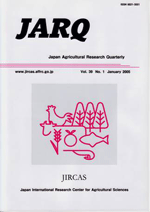Controlled Environment Agriculture for Effective Plant Production Systems in a Semiarid Greenhouse
| ISSN | 00213551 |
|---|---|
| 書誌レコードID(総合目録DB) | AA0068709X |

Semiarid climate regions have great potential for productivity due to large amounts of solar radiation throughout year. However, these regions also have disadvantages, such as excessive air temperature and limited water use. Optimizing the ventilation rate and evapotranspiration during fog cooling in combination with natural ventilation will provide more favorable growing conditions for plants in a semiarid climate and allow less water use. A single-span greenhouse at The University of Arizona was used to investigate the fog cooling performance on clear days with excessively high air temperature.The environmental conditions and the natural ventilation rate were measured. The performance of fog cooling in combination with natural ventilation was compared with pad-and-fan cooling. Fog cooling and pad-and-fan cooling used 24 g m-2 min-1 and 41 g m-2 min-1 of water, respectively. The air relative humidity for fog cooling was slightly higher than that for pad-and-fan cooling, at approximately 35%.An English version of Visual VETH (ventilation-evapotranspiration-temperature-humidity) software was also developed. A cooling strategy devised for semiarid greenhouses found that the air relative humidity inside a greenhouse decreased with an increase in ventilation rate as expected from simulation based on steady-state energy balance equations, while the water use for fog cooling increased. A simple and unique control algorithm for fogging and ventilation inlet openings demonstrated the possibility of maintaining relative humidity and air temperature simultaneously within a desirable range while reducing the water use for fog cooling. The tomato plant canopy transpiration rate and the water balance relative to the natural ventilation rate in a fog-cooled greenhouse were also investigated. The transpiration rate increased linearly with an increase in vapor pressure deficit (VPD) of the air. At a lower ventilation rate made possible by reducing the ventilation inlet openings, total water use in the greenhouse decreased by 13% and relative humidity increased as was expected from the steady-state energy balance simulation. The decrease in canopy transpiration resulted from the decrease in VPD, and was at a magnitude greater than that of the fog evaporation rate under similar experimental conditions with relatively high humidity in the range of 70-94%. By optimizing the natural ventilation rate, the greenhouse could be effectively cooled with less water use. Arizona can be considered a model analogous to many other semiarid climate conditions. Due to the long history of greenhouse technology development, the application of greenhouse crop production to an area with excessive radiation and dry air remains a relatively new effort. We believe that our efforts will contribute not only to the American Southwest but also to enhancing the application of greenhouse technology for crop production in these climate regions worldwide, including Mexico, China, the Middle East and Africa.
| 刊行年月日 | |
|---|---|
| 作成者 | Masahisa ISHII Sadanori SASE Hideki MORIYAMA Limi OKUSHIMA Atsuo IKEGUCHI Makio HAYASHI Kenji KURATA Chieri KUBOTA Murat KACIRA Gene A. GIACOMELLI |
| 著者キーワード |
air temperature evaporative cooling natural ventilation relative humidity water use |
| オンライン掲載日 | |
| 国立情報学研究所メタデータ主題語彙集(資源タイプ) | Journal Article |
| 巻 | 50 |
| 号 | 2 |
| 開始ページ | 101 |
| 終了ページ | 113 |
| DOI | 10.6090/jarq.50.101 |
| 権利 | Japan International Research Center for Agricultural Sciences |
| 関連するリソース | : J-STAGE |
| 言語 | eng |
